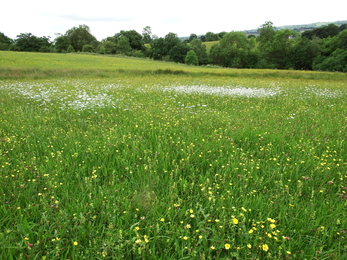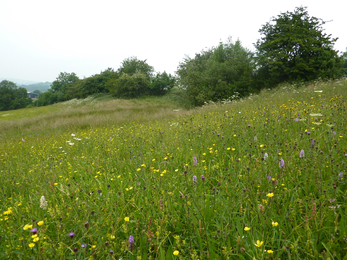Location
Know before you go
Dogs
When to visit
Opening times
Open at all timesBest time to visit
June to JulyAbout the reserve
A Coronation Meadow
In 2013, the reserve was recognised as a Staffordshire Coronation Meadow to celebrate the 60th anniversary of the Queen’s coronation. This resulted in green hay being collected from the site and used to enhance wild flower meadows at Cecilly Brook, Cheadle (now also managed by SWT).
The Coronation Meadows Project followed on from a report Our Vanishing Flora, published by Plantlife in 2012, highlighting the loss of wild flowers across Great Britain since the Coronation. In his foreword for the report, Plantlife's Patron, HRH The Prince of Wales called for the creation of new wild flower meadows to celebrate the 60th anniversary of the Coronation. The Coronation Meadows Project, was led by Plantlife in partnership with The Wildlife Trusts and the Rare Breeds Survival Trust, to achieve this goal.
Highlights
Visit the reserve in early July to see the flower rich meadows at their best and look out for wild orchids and lots of other colourful flowers.
On a clear day the reserve has spectacular views across to Leek, north Staffordshire and the Peak District. Why not enjoy a picnic on the bench near to the car park?
Our heathland restoration areas are developing quickly and can be seen flowering in late summer and early autumn.
What’s in a name?
Despite the name, woodland comprises only a small part of Rod Wood. The site is an interesting mosaic of scrub, unimproved grassland and woodland. This diversity of habitats is one of the reasons why Rod Wood is so important for wildlife. However the prime reason for purchase was the site’s unimproved pastures and hay meadows, a nationally declining habitat.
Timing is important
The three meadows support a wide range of flowering plants including many which are uncommon in Staffordshire. One of the most characteristic species found in unimproved hay meadows is the aptly named hay-rattle which grows in abundance at Rod Wood. Hay rattle is semi-parasitic on grasses and you’ll see in patches dominated by yellow rattle that the grass cover is reduced.
Anyone visiting the reserve in late June/early July will be rewarded with a spectacular display of wild flowers including oxeye daisy, eyebright, knapweed and orchids. But you’ll need to get there before the fields are cut in mid-July. After mowing the grass is left on the ground to dry for several days – this also allows any wild flower seeds to drop back onto the ground to make sure there are plenty of new plants in future years. With our unpredictable English summers you can imagine that making good quality hay is a skilled job!
Boggy bits
There are a number of other fields at the reserve which are too wet or steep to be managed as hay meadows. These ‘wet pastures’ are also rich in flowering plants including scabious, ragged robin, spearwort, marsh marigolds, meadowsweet, valerian and early purple orchids. You may not see the water mint, but walk over it and you’ll soon pick up the distinctive aroma.
The range of wild flowers in the pastures and meadows provides a haven for butterflies including meadow brown, speckled wood and green hairstreak – all of which are abundant on warm, sunny days.
Restoration!
The field nearest the car park is largely dominated by bracken. This field would historically have been heathland, which was once far more extensive through this area. Across the road at Ferny Hill you can still see an expanse of heather which historically would have extended to Rod Wood. We’ve been working hard to try and increase the extent of the heathland. Hunt around and you’ll find patches of ground which we’ve cleared to make way for regenerating heather plants.
A Living Landscape
This nature reserve is part of the Churnet Valley Living Landscape
'Living Landscapes' is The Wildlife Trusts innovative approach to nature conservation and involves focusing our efforts on improving the wider landscape to make it better for wildlife. Find out more here








